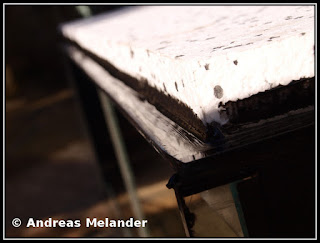The heater of a tropical aquarium is probably one of the necessities that have the highest energy consumption (unless you are packing some impressive light system), by simply insulating a tank you can save a few buck in the long run. It all ads up especially when keeping several tanks. Another positive side is that as the tank will retain the heat longer you will have more time to sort out a malfunctioning heater.
What you need: suitable amount of styrofoam or another insulating material, a carpet knife, a measuring tape, silicone and paint (optional)
Sheet of Styrofoam:

If you want a background (painted or not) on the outside of the tank now is the time to apply it. I choose to paint the back and sides of the tank before attaching the styrofoam. Make sure to leave a square free from paint around each piece of glass for the silicone, see the masking tape in the picture below:

Cut out the pieces of insulating material that you need and attach them to the rear (and sides) of the tank using silicone:

Detail of the silicone binder (a rough job i know:)):
The next step i optional. I decided to paint the styrofoam just to make it look less intrusive:
My tank is not a display tank but If your tank is a centerpiece it is worth to hide the insulation for instance in a rack or by lining it with wood panels.
Finally, it's never a bad idea to use styrofoam below the tank as well for a minimun heat loss:
That's all, a quick easy and cheap solution.
Melander




